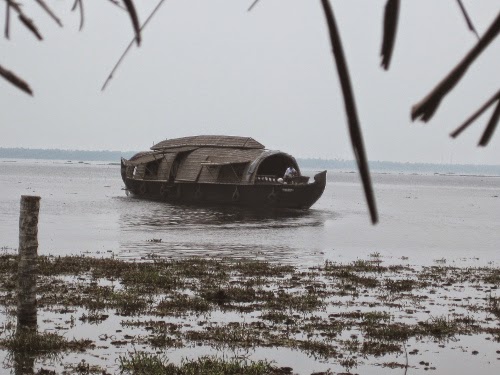 |
| Houseboats parked at Alleppey |
 |
| Houseboat on Lake Vembanad |
The kettuvallums, the traditional boats of all sizes, are living history. No-one knows how long they have been constructed using very ancient techniques, out of Anjuli wood and coir, both abundant around the area.
In the Malayalam language "kettu" means tying and “vallam” means country boat – the two together make the local name "kettuvallam”. Those tourists lucky enough to have a trip on a genuine kettuvallum will be treated to a close-up view of the complicated tying and weaving of the coir ropes which hold the whole thing together, and the intricately woven palm-thatched superstructure. The standard kettuvallam is about 20 metres long and 4 metres wide. They are still built using traditional construction methods and mainly from local materials, bamboo poles, coconut fibre and "Anjili" (Artocarpus hirsuta) wood. The hull is a series of wooden planks, long cut and carved and tied together using coir, with coconut fibres stuffed in between. There are no nails used in the hull, and it is easy to see how the planks are tied. This framework is then coated with a caustic black resin extracted from boiled cashew kernels. Modern boats have diesel engines and a rudder and are steered using a wheel at the front. Some maintain the use of bamboo poles to punt along.
 |
| A meal on the boat |
The distinctive kettuvallams have been used to transport rice and spices through the canals and waterways of Kerala for many years. They could be as much as 100 feet long and carry up to 30 tons. Today the boats are only used to carry visitors around the backwaters, their stately pace being the ideal counterpoint to the bustle onshore. From being an outmoded and dying form of transport, the kettuvallam has taken on a new lease of life and the boatyards are busy building and maintaining today’s fleet. The superstructure is made from woven bamboo, and needs to be renewed every three or four years.Inside, the boats now have every modern convenience including air-conditioning, en-suite bathrooms and well-equipped kitchens.
New boats use modern construction techniques and are metal-hulled and riveted together. They are usually lumbering monsters, lacking the grace of the traditional boats. Some have eight cabins and a jacuzzi on the roof. I just don't get it!
 |
| The driver |
The source of a lot of tourist dollars, the fleet of boats working out of Alleppey has grown and grown, and with little regulation the boats are adding to the already serious pollution of the lakes and waterways. Most of the beauty of the backwaters lies along its narrow canals, which thread their way through the rice fields, lined with small houses and providing the arteries through which the commerce of the area flows. The large boats with all mod. cons cannot tackle these waterways, so lumber their way round the lake, a constant procession of primitive arks. There is much to see on the lake, but those in the know insist on a small boat and a more difficult voyage into the depths of the backwaters.
No comments:
Post a Comment